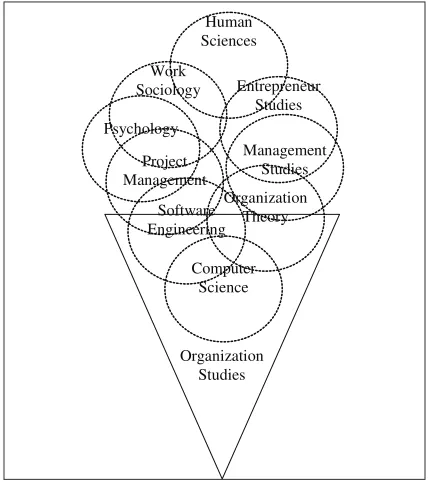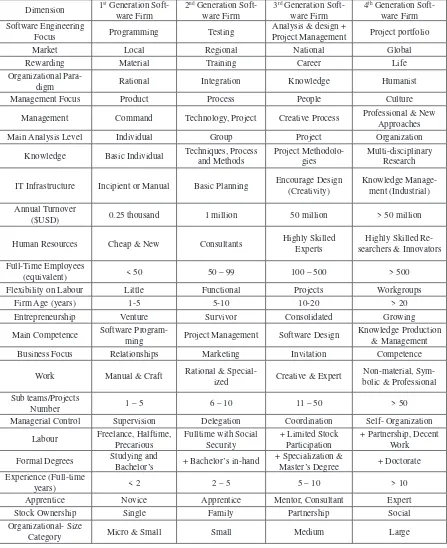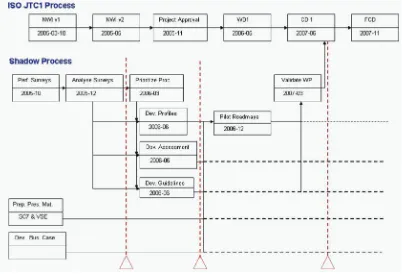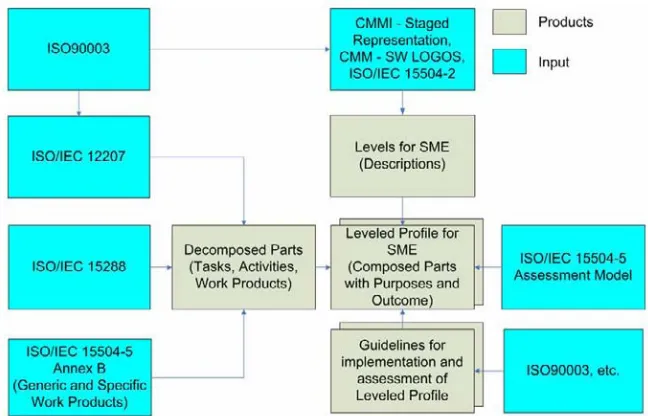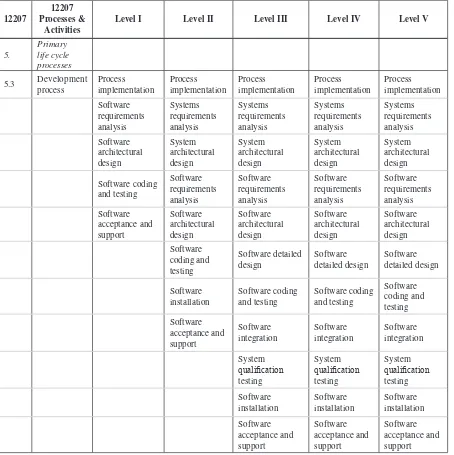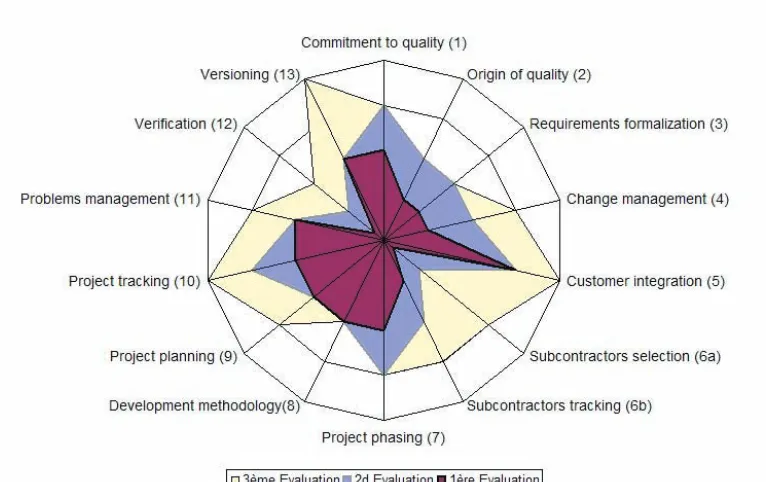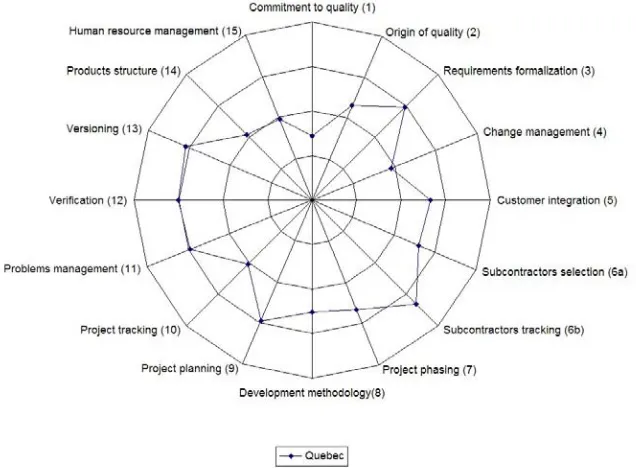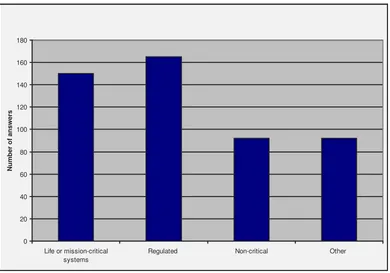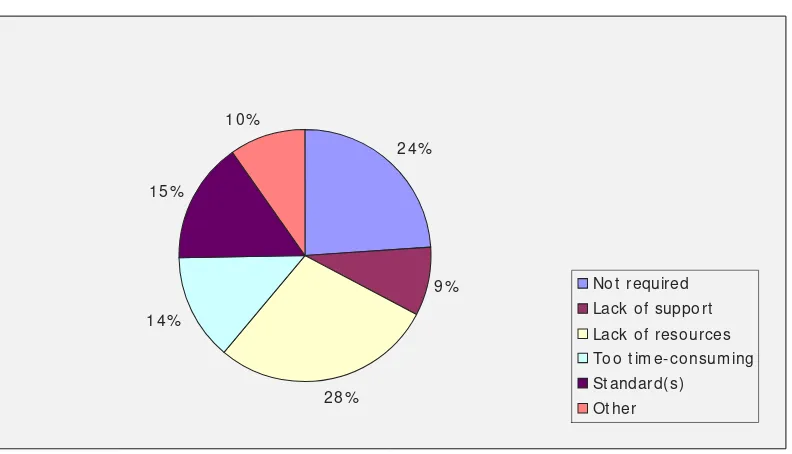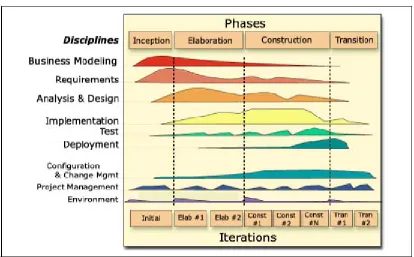Improvement for Small
and Medium Enterprises:
Techniques and Case Studies
Hanna Oktaba
Nacional Autonomous University of Mexico, Mexico
Mario Piattini
University of Castilla-La Mancha, Spain
Hershey • New York
Copy Editor: April Schmidt Typesetter: Cindy Consonery Cover Design: Lisa Tosheff Printed at: Yurchak Printing Inc.
Published in the United States of America by
Information Science Reference (an imprint of IGI Global) 701 E. Chocolate Avenue, Suite 200
Hershey PA 17033 Tel: 717-533-8845 Fax: 717-533-8661 E-mail: [email protected] Web site: http://www.igi-global.com
and in the United Kingdom by
Information Science Reference (an imprint of IGI Global) 3 Henrietta Street
Covent Garden London WC2E 8LU Tel: 44 20 7240 0856 Fax: 44 20 7379 0609
Web site: http://www.eurospanonline.com
Copyright © 2008 by IGI Global. All rights reserved. No part of this publication may be reproduced, stored or distributed in any form or by any means, electronic or mechanical, including photocopying, without written permission from the publisher.
Product or company names used in this set are for identification purposes only. Inclusion of the names of the products or companies does not indicate a claim of ownership by IGI Global of the trademark or registered trademark.
Library of Congress Cataloging-in-Publication Data
Software process improvement for small and medium enterprises : techniques and case studies / Hanna Oktaba and Mario Piattini, editors. p. cm.
Summary: "This book offers practical and useful guidelines, models, and techniques for improving software processes and products for small and medium enterprises, utilizing the authoritative, demonstrative tools of case studies and lessons learned to provide academics, scholars, and practitioners with an invaluable research source,"--Provided by publisher.
ISBN 978-1-59904-906-9 (hbk.) -- ISBN 978-1-59904-908-3 (e-book)
1. Computer software--Development--Management. 2. Computer software industry--Management--Case studies. 3. Small business--Data processing--Case studies. I. Oktaba, Hanna. II. Piattini, Mario, 1966-
QA76.76.D47S66354 2008 005.1--dc22
2008001869
British Cataloguing in Publication Data
A Cataloguing in Publication record for this book is available from the British Library.
All work contributed to this book set is original material. The views expressed in this book are those of the authors, but not necessarily of the publisher.
Foreword ...xii Preface ... xiv Acknowledgment ...xvii
Chapter I
Organizational Analysis of Small Software Organizations: Framework and Case Study ...1
Jesús Zavala-Ruiz, Metropolitan Autonomous University – Iztapalapa, Mexico
Chapter II
The Application of International Software Engineering Standards in Very
Small Enterprises ... 42
Claude Y. Laporte, École de Technologie Supérieure, Canada
Alain Renault, Centre de Recherche Public Henri Tudor, Luxembourg Simon Alexandre, Centre d’Excellence en Technologies de
l’Information et de la Communication, Belgium
Chapter III
Practical Experience in Customization for a Software Development Process for
Small Companies Based on RUP Process and MSF ...71
Valerio Fernandes del Maschi, Universidade Paulista, Brazil Mauro de Mesquita Spinola, Universidade Paulista, Brazil Ivanir Costa, Universidade Paulista, Brazil
Alexandre de Lima Esteves, Universidade Paulista, Brazil Luciano S. Souza, Universidade Paulista, Brazil
Chapter V
QuickLocus: A Software Development Process Evaluation Method for Small-Sized
Organizations ... 109
Sarah Kohan, Carlos Alberto Vanzolini Foundation, Brazil
Marcelo Schneck de Paula Pessôa, Escola Politécnica da Universidade de São Paulo, Brazil Mauro de Mesquita Spinola, Escola Politécnica da Universidade de São Paulo, Brazil
Chapter VI
A Study of Software Process Improvement in Small and Medium Organizations ...140
Deepti Mishra, Atilim University, Turkey Alok Mishra, Atilim University, Turkey
Chapter VII
CMM Fast-Track: Experience and Lessons Learned ...158
Hareton Leung, Hong Kong Polytechnic University, Hong Kong Yvette Lui, Hong Kong Polytechnic University, Hong Kong
Chapter VIII
MoProSoft®: A Software Process Model for Small Enterprises ...170
Hanna Oktaba, Universidad Nacional Autónoma de México, Mexico
Ana Vázquez, Asociación Mexicana para la Calidad en la Ingeniería de Software, Mexico
Chapter IX
Agile SPI: Software Process Agile Improvement—A Colombian Approach to
Software Process Improvement in Small Software Organizations ...177
Julio A. Hurtado, University of the Cauca, Colombia Francisco J. Pino, University of the Cauca, Colombia Juan C. Vidal, University of the Cauca, Colombia César Pardo, University of the Cauca, Colombia
Luís Eduardo Fernández, University of the Cauca, Colombia
Chapter X
Agile Practices in Project Management ...193
John Gómez, Ericsson Chile, Chile
Hanna Oktaba, Facultad de Ciencias, Universidad Nacional Autónoma de México, Mexico Francisco J. Pino, University of the Cauca, Colombia
Mario Piattini, Alarcos Research Group, University of Castilla-La Mancha, Spain Félix García, Alarcos Research Group, University of Castilla-La Mancha, Spain Claudia Alquicira, Ultrasist, Mexico
Francisco Ruiz, Alarcos Research Group, University of Castilla-La Mancha, Spain Tomás Martínez, Alarcos Research Group, University of Castilla-La Mancha, Spain
Chapter XII
SPI Long-Term Benefits: Case Studies of Five Small Firms ...223
Aileen Cater-Steel, University of Southern Queensland, Australia Terry Rout, Griffith University, Australia
Chapter XIII
An Incremental Functionality-Oriented Free Software Development Methodology ...242
Oswaldo Terán, ENDITEL; Centro de Micro Electrónica y Sistemas Distribuidos and Centro de Simulación y Modelos, Universidad de los Andes, Venezuela
Johanna Alvarez, CENDITEL, Venezuela
Blanca Abraham, CEMISID Universidad de los Andes, Venezuela
Jose Aguilar, CENDITEL; Centro de Micro Electrónica y Sistemas Distribuidos, Universidad de los Andes, Venezuela
Chapter XIV
How to Align Software Projects with Business Strategy ...258
Gustavo Ricardo Parés Arce, Instituto Tecnológico y de Estudios Superiores de Monterrey Campus Santa Fe, Mexico
Chapter XV
A Model to Classify Knowledge Assets of a Process-Oriented Development ...280
Raquel Anaya, Universidad EAFIT, Colombia
Alejandra Cechich, Universidad Nacional del Comahue, Argentina Mónica Henao, Universidad EAFIT, Colombia
Chapter XVI
Practical Application of a Software Development Framework in an Accountant Office ...296
Claudia Alquiciral Esquivel, Ultrasist, Mexico
Chapter XVIII
Improving Resource Management: Lessons from a Case Study in a
Middle-Range Governmental Organization ...327
Juan M. Luzuriaga, Poder Judicial de la Provincia de Neuquén, Argentina Rodolfo Martínez, Poder Judicial de la Provincia de Neuquén, Argentina
Alejandra Cechich, GIISCo Research Group, Universidad Nacional del Comahue, Argentina
Compilation of References ... 342
About the Contributors ... 364
Foreword ...xii Preface ... xiv Acknowledgment ...xvii
Chapter I
Organizational Analysis of Small Software Organizations: Framework and Case Study ...1
Jesús Zavala-Ruiz, Metropolitan Autonomous University – Iztapalapa, Mexico
This chapter contains an overview on the complexity of a software organization focusing on the around software engineering and project management as disciplines in crisis and their underlying management paradigm. The author considers opening it to those related disciplines and presents a framework to sup-port this change of paradigm.
Chapter II
The Application of International Software Engineering Standards in Very
Small Enterprises ... 42
Claude Y. Laporte, École de Technologie Supérieure, Canada
Alain Renault, Centre de Recherche Public Henri Tudor, Luxembourg Simon Alexandre, Centre d’Excellence en Technologies de
l’Information et de la Communication, Belgium
Valerio Fernandes del Maschi, Universidade Paulista, Brazil Mauro de Mesquita Spinola, Universidade Paulista, Brazil Ivanir Costa, Universidade Paulista, Brazil
Alexandre de Lima Esteves, Universidade Paulista, Brazil Luciano S. Souza, Universidade Paulista, Brazil
Wilson Vendramel, Universidade Paulista, Brazil Jorge Pirola, Universidade Paulista, Brazil
This chapter shows the methodology, strategy, main phases, and procedures to the implantation of a customized software engineering process in a SME.
Chapter IV
The Impact of Software Testing in Small and Medium Settings ...94
Luis Vinicio León-Carillo, e-Quallity Corporation and ITESO University, Mexico
This chapter shows some foundations of the discipline of software testing and fragments of some suc-cessful test process defined using a proprietary process definition language and presents two case studies realized in Mexican SMEs that show the economic impact of the testing process.
Chapter V
QuickLocus: A Software Development Process Evaluation Method for Small-Sized
Organizations ... 109
Sarah Kohan, Carlos Alberto Vanzolini Foundation, Brazil
Marcelo Schneck de Paula Pessôa, Escola Politécnica da Universidade de São Paulo, Brazil Mauro de Mesquita Spinola, Escola Politécnica da Universidade de São Paulo, Brazil
This chapter presents a low-cost process evaluation method especially designed for SMEs that has been successfully apply in several organizations and provides ways to be more competitive.
Chapter VI
A Study of Software Process Improvement in Small and Medium Organizations ...140
Deepti Mishra, Atilim University, Turkey Alok Mishra, Atilim University, Turkey
This chapter presents the CMM Fast-track Toolkit (CMMFT) that provides a faster and cheaper method of obtaining CMMI capability for SMEs, increasing quality of their software products and gaining competitive advantage.
Chapter VIII
MoProSoft®: A Software Process Model for Small Enterprises ...170
Hanna Oktaba, Universidad Nacional Autónoma de México, Mexico
Ana Vázquez, Asociación Mexicana para la Calidad en la Ingeniería de Software, Mexico
This chapter resumes the process model (MoProSoft) and its assessment method (EvalProSoft) and shows their most important features. It also includes the results of their application in four small Mexi-can enterprises.
Chapter IX
Agile SPI: Software Process Agile Improvement—A Colombian Approach to
Software Process Improvement in Small Software Organizations ...177
Julio A. Hurtado, University of the Cauca, Colombia Francisco J. Pino, University of the Cauca, Colombia Juan C. Vidal, University of the Cauca, Colombia César Pardo, University of the Cauca, Colombia
Luís Eduardo Fernández, University of the Cauca, Colombia
This chapter presents the framework Agile SPI, designed to motivate SMEs towards improving and certifying their software development processes, which is based on the integration of software processes on small and medium organizations context and culture.
Chapter X
Agile Practices in Project Management ...193
John Gómez, Ericsson Chile, Chile
Alejandro Núñez, Practia Consulting S.A., Chile
Hanna Oktaba, Facultad de Ciencias, Universidad Nacional Autónoma de México, Mexico Francisco J. Pino, University of the Cauca, Colombia
Mario Piattini, Alarcos Research Group, University of Castilla-La Mancha, Spain Félix García, Alarcos Research Group, University of Castilla-La Mancha, Spain Claudia Alquicira, Ultrasist, Mexico
Francisco Ruiz, Alarcos Research Group, University of Castilla-La Mancha, Spain Tomás Martínez, Alarcos Research Group, University of Castilla-La Mancha, Spain
This chapter presents the COMPETISOFT project and its framework for improving software process in Latin-American SMEs. This framework is composed by a reference process model, an assessment model, and an improvement model, and it is based on other previous solutions, especially in the MoPro-Soft project.
Chapter XII
SPI Long-Term Benefits: Case Studies of Five Small Firms ...223
Aileen Cater-Steel, University of Southern Queensland, Australia Terry Rout, Griffith University, Australia
This chapter presents a study of assessment-based improvement in more than 20 SMEs during five years; its results show how improving frameworks can affect the organization and its business.
Chapter XIII
An Incremental Functionality-Oriented Free Software Development Methodology ...242
Oswaldo Terán, ENDITEL; Centro de Micro Electrónica y Sistemas Distribuidos and Centro de Simulación y Modelos, Universidad de los Andes, Venezuela
Johanna Alvarez, CENDITEL, Venezuela
Blanca Abraham, CEMISID Universidad de los Andes, Venezuela
Jose Aguilar, CENDITEL; Centro de Micro Electrónica y Sistemas Distribuidos, Universidad de los Andes, Venezuela
This chapter shows the validated methodology used in a factory oriented at free software development. This incremental methodology is based on a prioritization of functionalities development according to needs and has features of both cathedral and bazaar developing styles.
Chapter XIV
How to Align Software Projects with Business Strategy ...258
Gustavo Ricardo Parés Arce, Instituto Tecnológico y de Estudios Superiores de Monterrey Campus Santa Fe, Mexico
Mónica Henao, Universidad EAFIT, Colombia
This chapter identifies a model to characterize knowledgeable assets and their relationships in a software organization, and it sets the basis for defining a transversal process of knowledge management at the organization.
Chapter XVI
Practical Application of a Software Development Framework in an Accountant Office ...296
Alicia Mon, La Matanza National University, Argentina Marcelo Estayno, La Matanza National University, Argentina Patricia Scalzone, La Matanza National University, Argentina
This chapter describes a framework implementation experience in an accounting office by showing how its process definition allows for progressively putting a work model into practice for implementing a process model with continuous improvement.
Chapter XVII
Estimate of Effort in Software Implementation Projects ...313
María Julia Orozco Mendoza, Ultrasist, Mexico Evaristo Fernández Perea, Ultrasist, Mexico Claudia Alquiciral Esquivel, Ultrasist, Mexico
This chapter contains a proposal for project estimation of software used in a Mexican SME, based on the Karner’s use case point estimation method. Two methods are compared to provide conclusions.
Chapter XVIII
Improving Resource Management: Lessons from a Case Study in a
Middle-Range Governmental Organization ...327
Juan M. Luzuriaga, Poder Judicial de la Provincia de Neuquén, Argentina Rodolfo Martínez, Poder Judicial de la Provincia de Neuquén, Argentina
Alejandra Cechich, GIISCo Research Group, Universidad Nacional del Comahue, Argentina
This chapter presents how resources have been managed according to recommendations of the MoPro-Soft reference model in a governmental organization and presents some lessons learned from this case study.
Compilation of References ... 342
Foreword
There is little disagreement within the software community about the need for addressing process im-provement within small businesses and projects. Small businesses in the software industry represent a significant amount of the resources applied to software problems around the world. These businesses sometimes plan on staying small, but often they hope that they will grow with success. Particularly for those who plan on growing, understanding how processes that are well-conceived, described, and used can contribute to their success in the business world is critical to attain and sustain competitiveness.
As important as this is, small businesses often find there are many more “urgent” concerns that claim their attention. This is exacerbated by the perception that defining, training, and following disciplined processes is too much work in comparison to the benefit today. Because small businesses are so often worried about day-to-day survival, thinking about how processes can help them tomorrow is often at the bottom of their priority list. Not to mention, small software companies rarely have the internal expertise and resources to perform process definition and improvement activities themselves. This means added cost that is rarely considered in the survival-level business plan.
Governments across the world have taken note of these challenges for the small businesses within their economies and have instituted a variety of approaches to encourage and support their small software businesses in taking process improvement seriously. One of the most ambitious of these government initiatives is Mexico’s MoProSoft initiative. This initiative built a national norm (in the U.S., it would be called a standard) that is explicitly targeted at the pequeña (tiny) software organizations in Mexico. The MoProSoft team looked not only at the process topics covered in other common international standards and guides, but they also identified the need in these small organizations to deal explicitly with business strategy issues, a unique contribution to the process improvement community. It is one of the several techniques that Hanna Oktaba and Mario Piattini have included in this volume.
MoProSoft does not intend to replace more widely used process improvement standards like ISO 9001 or CMMI. However, it does fill a gap for those organizations that are ready for “some” type of improvement, but that are still sufficiently taken up with business survival issues that they do not feel ready to take on the more prominent standards fully. In my conversations with Hanna and other au-thors of the norm, it is clear that their dedication to encouraging productive improvement activities in organizations that normally would not engage in improvement is a goal that they hold dear. This book covers both the challenges that led to solutions like MoProSoft as well as other productive approaches to improving processes in small settings.
for some of the issues commonly present with the smaller organizations you work with. In any case, we all have much to learn from both the successes and the struggles of small organizations working to adopt improved processes that are provided here.
Preface
From the very beginning of the 1990s onward, the software engineering community (industry and researchers) has expressed special interest in software process improvement (SPI). This is evidenced by the growing number of books, articles, and conferences that deal with the topic of SPI and the great number of international initiatives related to SPI such as CMM®, CMMI®, ISO/IEC 12207, 15504, and ISO 90003, among others.
Nevertheless, these standards and models are conceived for big organizations like USA DoD, NASA, multinational software factories, and so forth. In fact, there is a widespread tendency to emphasize that the success of SPI is only possible for large companies that have enough resources to tackle these types of practices. This perception is based on the fact that SPI programs are just not viable for small and me-dium enterprises (SMEs) because of their organizational structure and the high costs that are involved. However, the software industry in most countries is made up mainly of SMEs which favor the growth of national economies. Most software development organizations (nearly 90%) are SMEs which contribute to very valuable and widespread products.
Almost all the experts agree that the special characteristics of SMEs mean that process improvement programs must be applied in a way that is particular to them and visibly different from how this is done in the large organizations. This is not as simple as just regarding these programs as scaled down versions of those applied in big companies. In fact, the assessments conformant to the international standards are expensive and time consuming, difficult to perform in small companies, their process model structure is too complex, and the return of investment undertaken has to be seen from a long-term perspective.
The first International Research Workshop for Process Improvement in Small Settings organized by the Software Engineering Institute (October 2005), the new ISO/IEC JTC1 SC7 Working Group 24, which was created (2006) to develop the “Software Life Cycle Profiles and Guidelines for use in Very Small Enterprises (VSE),” and several other initiatives have demonstrated the increasing interest for new proposals and experiences in software improvement for SMEs. SMEs have become concerned about how to improve the capability of their software processes, as a fundamental element to increase product quality, addressing two main concerns: the first one has to do with their image, which is a key factor in order to be able to export software and hence enter the global marketplace; and the other concern is related to the efficiency and effectiveness of software process management.
The book consists of 18 chapters. The chapters seek to provide a critical survey of the fundamental themes, problems, arguments, theories, and methodologies in the field of software process improvement in SMEs. Each chapter has been planned as a self-standing introduction to its subject.
Therefore, in Chapter I, “Organizational Analysis of Small Software Organizations: Framework and Case Study,” Jesús Zavala Ruiz realizes an overview on the complexity of a software organization focusing on software engineering and project management as disciplines in crisis and their underlying management paradigm. He considers opening it to those related disciplines and presents a framework to support this change of paradigm.
Claude Y. Laporte, Alain Renault, and Simon Alexandre, in Chapter II, “The Application of Interna -tional Software Engineering Standards in Very Small Enterprises,” present the new ISO project proposed to facilitate access to, and utilization of, its standards in SMEs by means of developing profiles and providing guidance for compliance with ISO software engineering standards.
In Chapter III, “Practical Experience in Customization for a Software Development Process for Small Companies Based on RUP Process and MSF,” Valerio Fernandes del Maschi, Mauro de Mesquita Spinola, Ivanir Costa Alexandre de Lima Esteves, Luciano S. Souza, Wilson Vendramel, and Jorge Pirola, show the methodology, strategy, main phases, and procedures to the implantation of a customized software engineering process in a SME.
Chapter IV, “The Impact of Software Testing in Small and Medium Settings,” by Luis Vinicio León-Carrillo, shows some foundations of the discipline of software testing and fragments of some successful test process defined using a proprietary process definition language. He presents two case studies realized in Mexican SMEs that show the economic impact of the testing process.
Sarah Kohan, Marcelo Schneck de Paula Pessôa, and Mauro de Mesquita Spinola present “QuickLo -cus: A Software Development Process Evaluation Method for Small-Sized Organizations” (Chapter V). This is a low-cost process evaluation method especially designed for SMEs that has been successfully apply in several organizations which provide ways to be more competitive.
In Chapter VI, Deepti Mishra and Alok Mishra present “A Study of Software Process Improvement in Small and Medium Organizations,” in which some process assessment and software process improvement methods for SMEs are compared. This will lead towards development of a standardized software process improvement model for small and medium sized software development organizations in the future.
“CMM Fast-Track: Experience and Lessons Learned,” Chapter VII, by Hareton Leung and Yvette Lui, presents the CMM Fast-track Toolkit (CMMFT). This program aims to provide a faster and cheaper method of obtaining CMMI capability for SMEs, increasing the quality of their software products and gaining competitive advantage.
Chapter VIII, written by Hanna Oktaba and Ana Vázquez, presents “MoProSoft: A Software Proc -ess Model for Small Enterprises.” This chapter resumes the proc-ess model and its ass-essment method (EvalProSoft) and shows their most important features. It also includes the results of their application in four small Mexican enterprises.
Julio A. Hurtado, Francisco J. Pino, Juan C. Vidal, César Pardo, and Luis Eduardo Fernández present “Agile SPI: Software Process Agile Improvement: A Colombian Approach to Software Process Im -provement in Small Software Organizations” in Chapter IX. This framework (Agile SPI), designed to motivate SMEs towards improving and certifying their software development processes, is based on the integration of software processes in small and medium organization contexts and cultures. Knowledge regarding the organization and its main features let processes generate profits and increase the intel -lectual capital of the organization.
that may appear in a process improvement initiative. They explain how these practices can reduce the efforts and cost, and contribute to realize benefits sooner, in a motivational way.
A framework for improving software process in Latin-American SMEs is being developed by the COMPETISOFT project. This framework is composed by a reference process model, an assessment model, and an improvement model, and it is based on other previously solutions, especially in the Mo-ProSoft project. COMPETISOFT is shown in Chapter XI, “COMPETISOFT: An Improvement Strategy for Small Latin-American Software Organizations,” written by Hanna Oktaba, Mario Piattini, Félix García, Francisco J. Pino, Claudia Alquicira, Francisco Ruiz, and Tomás Martínez.
Chapter XII, “SPI Long-Term Benefits: Case Studies of Five Small Firms,” written by Aileen Cater-Steel and Terry Rout, presents a study of assessment-based improvement in more than 20 SMEs during five years. The results show how improving frameworks can affect the organization and its business.
Oswaldo Terán, Johanna Alvarez, Blanca Abraham, and Jose Aguilar show in Chapter XIII, titled “An Incremental Functionality-Oriented Free Software Development Methodology,” the validated methodology used in a factory oriented at free software development. This incremental methodology is based on a prioritization of functionalities development according to needs and has features of both cathedral and bazaar developing styles.
“How to Align Software Projects with Business Strategy” (Chapter XIV) by Gustavo Ricardo Parés Arce, proposes a methodological framework to promote strategic alignment, improve execution through better communication, and understand IT projects. It will help to make better IT decisions for offering a competitive edge to companies based on a better management of the strategic IT portfolio.
Chapter XV, “A Model to Classify Knowledge Assets of a Process-Oriented Development,” written by Raquel Anaya, Alejandra Cechich, and Mónica Henao, identifies a model to characterize knowledgeable assets and their relationships in a software organization, and it sets the basis for defining a transversal process of knowledge management at the organization.
Alicia Mon, Marcelo Estayno, and Patricia Scalzone describe a framework implementation experi-ence in an accounting office in Chapter XVI, titled “Practical Application of a Software Development Framework in an Accountant Office” They show how their process definition allows progressively putting a work model into practice for implementing a process model with continuous improvement.
Chapter XVII, “Estimate of Effort in Software Implementation Projects” by María Julia Orozco Mendoza, Evaristo Fernández Perea, and Claudia Alquicira Esquivel, contains a proposal for project estimation of software used in a Mexican SME. This is based on Karner’s use case point estimation method. Two methods are compared to provide conclusions.
In “Improving Resource Management: Lessons from a Case Study in a Middle-Range Governmental Organization,” Chapter XVIII, Juan M. Luzuriaga, Rodolfo Martínez, and Alejandra Cechich present how resources have been managed according to recommendations of the MoProSoft reference model in a governmental organization. They present some lessons learned from this case study.
In summary, these chapters constitute evidence of the importance of software process improvement in SMEs. These are intended to be useful to a wide audience, including CEOs, CIOs, software engineers, software process engineers, quality specialists, consultants, and software students.
Acknowledgment
This work has been funded by the “Process Improvement for Promoting the Competitiveness of Small and Medium Iberoamerican Software Enterprises – 506AC0287 COMPETISOFT” project financed by CYTED (Cooperación y Tecnología para el Desarrollo). We would like to thank Suz García for writing the foreword, for which we are truly grateful. We would also like to thank Tomás Martínez of UCLM for his support during the development of this book.
Chapter I
Organizational Analysis of
Small Software Organizations:
Framework and Case Study
Jesús Zavala-Ruiz
Metropolitan Autonomous University – Iztapalapa, Mexico
IntroductIon
In modern society, service-related activities are growing in importance. Software is playing a preponderant role. More and more, organizations depend on data-processing processes and on the
abilities of highly skilled and scarce personnel. They have been named knowledge workers and this kind of organization is named knowledge intensive firms (Alvesson, 2004, p.5ss)or post-modern organizations. Software organizations are a paradigmatic case of intensive-knowledge
abstract
organizations for many reasons, but principally because its main work is symbolic or non-material in nature and because it is non-standard work for its labour conditions.
Paradoxically, most software organizations are not characterized as applying to themselves what they promote for others. A closer, detailed look inside them frequently reveals a totally different situation: while in the business, most productive, administrative and management processes are candidates for automation, in software organiza-tions, these processes still continue to develop in a craft-like and chaotic manner. The same thing happens in the systems department of any organization. Software production and the most of the work relating to information technology have succumbed to the culture of urgency and competition typical of management. Business cycles decrease and everything is in constant change, with the rising pressure of changing information systems.
Management in software organizations, in a process of imitation, has attempted to adopt the same management recipes applied in business. In this way, it has succumbed to management fads. One of these clearly is total quality management
(TQM), adopting the name of the normative stan-dards of that moment. Many TQM initiatives have failed miserably in practice in small businesses as well as in large ones. However, in implementing these organizational models, organizational limits exist for their full application, most importantly in small and medium enterprises (SMEs). Resource constraints in SMEs at all levels (monetary, hu-man, time, opportunity, etc.) make it impossible to adhere completely to such prescriptions. Ad-ditionally, those organizational characteristics, such as size, diversity, structure and formaliza-tion, impose specific restrictions since causes can be manipulated, but not effects. Possibly, the consideration of formal-informal structure duality is the most important, because it provokes both structures to distance themselves from each other, making a close attachment of the informal one to
the formal one practically impossible and expen-sive. But this structural duality is present in all aspects of the organization and software projects become chaotic because of that, among others. To analyze this organizational complexity, which is magnified in small organizations, a framework has been developed based on organization studies and with a social constructionism approach.
This chapter is organized into three parts. In the first part, I provide an overview of the orga -nizational paradigms that allow estimating the complexity of the organization conceived as a social construct beyond its classical mechanics and simple vision. This way, the organization appears as complex, multi-dimensional and multi-para-digmatic. Additionally, I provide an overview the three disciplines that support software production: management, project management and software engineering. I end with a recounting of facts pointing to software engineering as a discipline in crisis, and the causes of that crisis identified.
background
organization in an organization
studies approach
In their essay Organizations, Organization and Organizing, Steward R. Clegg and Cynthia Hardy (1996) give the most commonly accepted definition of Organization Studies as “a series of conversa -tions,” in particular those of organization-studies researchers who help to constitute organizations through terms, “derived from paradigms, methods and assumptions, themselves derived from earlier conversations” (p. 3). In other words, organization studies are “a place of meeting”, “a crossroads,” of disciplines and discourses as Luis Montaño Hirose observes (Montaño, 2005). Therefore, organiza -tion studies embrace disciplines like engineering, management, economics, psychology, sociology, anthropology and human sciences, among others, all revolving around organizations. Similarly, an
organization is:
“a collective with a relatively identifiable frontier, a normative order, levels of authority, systems of communications and of coordination; this collec-tive exists in a continuous way in an environment which is involved in activities that are related in general around a group of goals; the activities throw results for the members of the organization, the same organization and the society.” (Scott, 1992, p. 25)
In an organization studies approach, accord-ing to Clegg and Hardy (1996), organizations
are conceived as “empirical objects” (p. 3) and “sites of situated social action more or less open both to explicitly organized and formal disciplin-ary knowledges [...] and also to conversational practices embedded in the broad social fabric” (p. 4). In other words, organizations are social constructs depending on the participants and the approach used to study them. Two related concepts are organization, conceived as a “theo
-retical discourse,” and organizing, as a “social
process” (p. 3). It is still an on-going debate, but it shows a multi-dimensional arrangement of all organizations.
Now I’ll review the most common paradigms accepted in organizations. In his essay Organi-zational Theorizing: A Historically Contested Terrain, Michael Reed (1996) has provided an instructional account of the analytical narratives and the ethical discourses shaping organization studies. The overview of organization theory has been structured using Reed’s framework. It captures the complete array of theorizing to date and provides a useful guide for a more sophisti-cated exploration. ‘Organization’, ‘human being’ and ‘management’ have been chosen as central categories for the ontological characterization of each paradigm. In an epistemological point of view, the most representative theories or ap-proaches close to each paradigm have been cited, being illustrative rather than exhaustive. In this sense, Reed parses organization theory into six analytical metanarratives, in a progressive and historical approach.
Reeds’ (1996) first paradigm is rationality, illustrated with the phrase “from night watchman state to industrial state.” It conceives organization
as a rationally constructed artefact for resolving collective problems of social order and admin-istrative management (p. 29). In other words, organization is conceived as a tool or instrument
science (p. 30). Taylorism is “an important com -ponent of the philosophical outlook of modern industrial civilization” (p. 29) quite close to the rational paradigm. Epistemology is supported by bounded rationality, administrative behaviour and decision-making theories. Strategic analysis inscribes in this way also. This paradigm has been the most dominant in the past and at present.
Reed’s (1996) second paradigm is integration
(“from entrepreneurial capitalism to welfare capitalism”). The ontologies of this paradigm are organization conceived as a social system
that facilitates the integration of individuals into society. Human beings are discovered as more social and psychological, that is, rational, emo-tional, and social rather than only raemo-tional, and
management is reinforced by social engineering and flexible design. Epistemology is supported by sociotechnical systems and contingency theories, among others, always in a structural-functionalist and systems approach (pp. 31-32).
Reeds’ (1996) third paradigm is market (“from
managerial capitalism to neo-liberal capitalism”). This paradigm conceptualizes organization as a unitary social and moral order in which indi-vidual and group interests are fitted and lead by suprahuman and live market forces. Human be-ings are cooperative agents rewarded by material, economic and moral incentives. Management
leads invisible market forces oriented to visible organizing. Epistemology uses agency and firm
theories grounded in this paradigm (pp. 33-34). Reeds’ (1996) fourth paradigm is power
(“from liberal collectivism to bargained cor -porativism”). In this paradigm, organization is conceived as a place of “conflicting interests and values constituted through power struggle” and power is responsible for success and failures in organizations. Human beings are immersed in the domination logic as dominant or as dominated, that is, involved in a power game. Management is based on episodic, manipulative and hegemonic power using institutional and political discourses.
Epistemology utilizes Weberian and Foucauldian
approaches widely, and labour-process theory and total quality management emerged from this paradigm (pp. 34-35).
Reeds’ (1996) fifth paradigm is knowledge
(“from industrialism/modernity to post-industri -alism/post-modernity”) that conceives ontologies as follows: organization as “a socially constructed and sustained ‘order’ necessarily grounded in the localized stocks of knowledge, practical routines and technical devices” (p. 36), that is, as result of “the condensation of local cultures of values, power, rules, discretion and paradox” (Clegg, cited by Reed, 1996, p. 36). The glocality (impact glob-ally, act locally) is a common discourse. Human beings are the new skilled workers, empowered by knowledge but in conflict with management (e.g., computer programmer). Management is faced with the challenge of managing empow-ered knowledge workers as experts without de-stroying their innovative initiatives in a cultural global/local environment. Epistemology favours ethnomethodology, postmodernist, neorationalist, actor-network and poststructuralist approaches (pp. 35-36).
Reeds’ (1996) sixth paradigm is justice (“from repressive to participatory democracy”). Ontology in this paradigm conceives the organization as an institutionalized structure of power and author-ity surrounding the localized micropractices of organizational members (p. 37), but tending to be a paradoxical and chaotic, but ordered new post-modern organization. Human beings are institutionally and organizationally mobilized, but historically and culturally grounded, and professionalism is promoted. Management is reinforced by social and economic governance.
Epistemology utilizes neo-institutionalism and postmodernism intended to address complexity using an inclusive, multi-disciplinary approach. Positivist/constructivist philosophical and epis-temological debate occurs (p. 39).
In my opinion, Reed’s (1996) framework may be extended to a seventh paradigm: the human
from fragmented life to integrative life. This paradigm conceives of an organization as a social construct and discourse, a place for economic purposes but also for social and personal growth too. In other words, organizations are built by hu-man beings for huhu-man beings serving huhu-manity, not serving against them. Human being includes rational, emotional, sentimental, social, objective, subjective, quantitative, and qualitative, among other complimentary human facets, all in ac-tion. Management is conceived as paradoxical, favouring innovation, liberty, and commitment. It abandons a fragmentary and disciplinary con-trol paradigm, and business firms turn into real ethical and socially responsible organizations.
Epistemology is based on multi-disciplinary hu-man sciences.
As I illustrated in the brief review of organiza-tion theory, the complexity of the organizaorganiza-tion is evident when each paradigm is added to the previ-ous one and the organization has been conceived as an object of study much more complex, because previous visions have not been abandoned but have been incorporated into current ones.
software organIzatIon:
a Post-IndustrIal factory or
a Post-modern shoP?
Software organization or software firm, also known ironically as software factory, may be conceived in different ways: (1) a production factory of interchangeable parts (McIlroy, 1969), or rational paradigm; (2) complex strategic man-agement and production infrastructure facilities
(Laporte, Papiccio, & Trudel, 1998, p. 1), or power paradigm; (3) a manufacturing, product develop -ment, and automation flexible factory (Griss & Wendtzel, 1994, p. 48), or market paradigm; or (4) an experience factory (Basili, Caldiera, & Rombach, 2002, p. 8), or knowledge paradigm. The final definitions of software organization are close to the logic of an organization as an evolution
of manufacturing with mass production lines in the rational and mechanistic management para-digm, Taylorian Scientific Management, but they are simplistic because organizations are so much more than production functions alone. The rational approaches adopted only “achieve” descriptions and quantitative calculus, but they are unable to successfully address the complex organizational and management issues involved in software de-velopment, because cause-effect schemes are not so clear in practice. In other words, the software organization may be conceived better as a social construct, not a thing that is not governed by linear cause-effect laws but rather by social, non-predictive and irrational organizational behaviour (social process or social interaction) as illustrated by Reed’s (1996) paradigm framework and the constructionism approach has proposed (cf. Burr, 2003, p. 1ss; Hibberd, 2005, p. 2ss).
But a clear characterization of the current software organization, adapted in a literary or-ganizational perspective, was depicted in master-fully by Moschedai Ben-Ari (1998). He narrates an imaginary visit to an ancient twenty-first century software factory in the year 2300. The most common characteristics of interest in this discussion are as follows.
First, according to Ben-Ari (1998), the produc-tion model of software organization is Taylorist, that is, a disciplinary system in a wide sense oriented toward controlling employees, process and product using authoritarian bureaucratic management:
In those pioneering days of the computer industry, there was apparently a strict division between professional engineers who knew how to design and build a computer, and another class of work-ers who adapted these computwork-ers to specific ap -plications. […] They were called ‘programmers’ or ‘software developers.’(p. 89)
euphe-mistic terms applied to someone who functioned as an authoritarian dictator of the factory. (p. 90)
Second, Ben-Ari (1998) states that software organization, frequently is immersed in the “high performance culture” based on the cheapest, disciplined, half-educated and inexperienced, but reckless, young workers. The business model
of software organization has a high-profit, short-term orientation. The productive consequences of this are high turnover rates, skilled-worker “piracy” between firms, the overexploitation and precariousness of the labour workforce, short productive work life, deficient software quality and “mercenary” behaviour, I consider:
Recently discovered historical documents show that the workers were forced to labour for fourteen to sixteen hours a day, six or seven days a week.
(Ben-Ari, 1998, p. 90)
The result of using mass [cheapest and disciplined]
labour was that the factory output was extremely high, but since it was produced by half-educated, inexperienced even reckless young workers, it was of such low quality that large numbers of work-ers were employed fixing flaws in the products. (p. 91)
Third, the personal and social impact exhibits anomie, out of balance, fragmentation and loss of meaning in social, personal and work life (Siev-ers, 1994, pp. 12-46), as well as work addiction (workaholism):
Not only was this extremely detrimental to their physical health, but therapists have shown that this leads to a complete breakdown of family and community life. Divorce was rampant and children of these workers showed high levels of psychological trauma resulting from parental neglect. (Ben-Ari, 1998, p. 90)
Finally, Ben-Ari describes a management style centred on a culture of excellence as a management paradigm facilitating enrollment of new employees and personnel management, but generally causing stress and burn-out:
Forensic psychologists believe that many people attracted to this discipline had infantile person-alities, and resisted efforts to place it on a sound economic footing. (Ben-Ari, 1998, p. 89)
One theory holds that a psychological technique called ‘brainwashing’ was used to convince software factory workers that labour under these conditions was spiritually rewarding and that selective admission to this prestigious profession was a mark of superiority. The theory is plausible, because the alternative that workers voluntarily accepted these conditions is outrageous. (p. 90)
Moschedar Ben-Ari’s literary description of software factory, in my opinion, ties into the char-acteristics of the typical software organization. In some aspects, management style in software organizations is similar to the psychic manage-ment or managinary management (managinary derives from a linguistic contraction of “man -agement” and “imaginary”) that was found in France by Aubert and Gaulejac (1993, parts 2-3) and Aubert (1994). This management style gets the psychic energy from its members, until the members burn-out. It occurs in large firms, but frequently also in SMEs. Asterion, who probably was a burned-out software worker when he wrote this message in his blog, illustrates it:
“July 18, 2005 I’m tired.
I’m fed up with my work.
discarding optimal solutions in favour of those taking less development time, without planning anything. Here [in Argentina] the expression ‘software architect’ we’ve never heard even the name of. Everything is improvised, with more or less degree of luck.
In our ‘software factory’ we are all equal. Rotten. And that’s the problem. People talk bad about the company, of those leading it, there’s bad vibes. There are meetings, comments, coteries. And I’m tired of that climate, tired of being hostage of those rumours of war.
We’re like a defeated army, perhaps the ‘wasted procession’ of which John Dryden spoke. Our work place is any old thing. It’s a house, far from downtown. We are packed like sardines. In the Winter we freeze and in the Summer the op-posite. There are too many people together in a very small space.
The worst thing of all is that there is no outlook of change. It’s always going to be like this, per secula seculorum, ad nauseam.
All these things, though I don’t want them to, affect me. They take away my desire to do things.
[…]
They sent me to work at another company, for several months.
The place is fantastic. It’s a modern, spacious office, very well set up.
But what really killed me is the labour climate. People come to work in good mood, awake, and apparently happy with the destiny they were lucky to get.
I have to go. Life doesn’t wait.” Asterion (2005)
This burn-out phenomenon demonstrates that an organization is a complex social system in which people work, create, desire, love, enjoy and live, but also destroy, hate, suffer and “die” (psychically speaking). When workers enroll in the organization, they interweave their own stories with the story of the organization. This specificity makes each organization unique in its existence
and for studying it: history, owner, leadership, entrepreneurship, management, people, produc-tion process, work, labour relaproduc-tions and culture, among others. There are no universal recipes for addressing that. The reader can appreciate that the multi-dimensional nature of the organization makes it very complex because it includes aspects such as economics, entrepreneurial aspects, management, work organization, coordination and communication, personnel management, relationship management, politics and sustain-ability, among others. Next this complexity will be analyzed.
the comPlexIty of the small
In software organIzatIon
Two important size aspects influencing the orga -nizational complexity are the size of the firm and the size of the workgroup. Categories of firm size depend on the research objective but, indepen-dently of this, in studying software organizations, one must similarly focus on a measure equivalent to a full-time worker, because personnel turnover is high, among other issues. The appropriate organizational size for software firms is not yet fully addressed and requires further in-depth research. There is no universal classification of firm size. Therefore, the criterion of both the Organisation for Economic Co-operation and Development (OECD) and the European Union may be appropriate. Formally, the definition of small and medium enterprise (SME) is:
Throughout the world, SMEs represent a large percentage of enterprises (up to 99%), economic output, employment (up to 70%) and innovation share (up to 60%), and provide flexibility to the economy (OECD, 2002, pp. 7-11). The most im-portant aspect, due to SMEs’ economic vulner-ability, is financing strategy during start-up, the most vulnerable stage. SME owners appeal to diverse financing sources, such as credit unions, leasing companies, as well as personal and family relations (p. 19).
Small companies differ from large ones in four major aspects: (1) territorial scope of action and mobility (small firms concentrate on local markets in contrast to multinational companies (MNC) because of their asymmetric power); (2)
innovation and organizational change (small firms are important sources of innovation and have innovative advantages in several respects: they spend less on research and development because of their limited available resources); (3)
regulations (compliance costs are relatively higher for SMEs); and (4) capital–labour ratio (SMEs usually require more labour-intensive work, labour productivity tends to be lower and unit labour costs are higher) (Traxler, 2005, p. 300). Due to these differences, it is comprehensible that large firms and small firms may have distinct and even conflicting interests (p. 301). Some precise obser -vations about SME characteristics are necessary: (1) small firms are essentially different, that is, not just smaller versions of large ones (Mugler, 2004, p. 2); (2) overwhelming evidence shows that smaller companies, in general, are not inferior to
larger units on economic performance and firm size (Aiginger & Tichy cited by Traxler, 2005, p. 300); (3) entrepreneurs and entrepreneurship play an important role, and entrepreneurship theory may be an alternative approach for studying SMEs (Mugler, 2004, p. 2); (4) the personality of the entrepreneur is often more critical; and (5) the owner of an SME generally will not replace himself/herself in cases of failure (Mugler, 2004, p. 5). In short, for small firms, four groups of variables play a decisive role: (1) the environment of the firm, (2) the resources of the firm, (3) the personality of the entrepreneur, and (4) the man-agement system adopted (Mugler, 2004, p. 7).
In SMEs, strategy and decision making are wide-ranging. A business owner uses direct observation, oral communication, direct sens-ing from the social environment (friends, fam-ily members, key employees, or quasi-famfam-ily members), market, partners, and competitors, including professional analysts and consultants (Mugler, 2004, p. 5), among others. Day-to-day activities in the organization differ greatly from those roles, stereotypes, and functions proposed by classic management, as Henry Mintzberg demonstrated. Two famous works caveat the most robust pillars of management, that is, manager’s work and decision-making: The Manager’s Job: Folklore and Fact (Mintzberg, 1975) and Decision Making: It’s Not What You Think (Mintzberg & Westley, 2001), showing there is not universal truth on managerial roles.
There are few studies on software organiza-tions that study firm size and performance. Carmel Enterprise
category Headcount Turnover Balance sheet total
Medium < 250 ≤ € 50 million ≤ € 43 million
Small < 50 ≤ € 10 million ≤ € 10 million
Micro < 10 ≤ € 2 million ≤ € 2 million
and Bird (1997) made a statistical study with a sample of 74 software firms in the business of soft -ware package development. The authors classify them as: (1) embryonic (1-19 employees), (2) small
(20-100 employees), and (3) medium-to-large
(over 100 employees). These authors focused on the organization workgroup and found that only 11 of 74 cases diverge from the “small team” (1-9 employees) and only 5 diverge by more than 50% (larger than 15) (paragraph: Measures). Alfredo Hualde (2004) studied the software industry linked to the maquila concept and the off-shore outsourc-ing phenomenon in Baja California, Mexico. He used a cluster perspective and confirms the small as the most common property, with a percentage of 75% of the sample ranked five employees or less (p. 15).
With regard to team size, it is frequently dem-onstrated that small teams of skilled developers can develop innovative complex applications on-time and on-budget, with high levels of quality and customer satisfaction (Carmel & Bird, 1997, paragraph: Team Size & Group Size; Greenfield & Short, 2003, p. 16). Software firms depend on highly skilled individuals, highly integrated and mature teams, and highly capable managers. In Bangalore, a study determined that, in the soft-ware industry, the organization’s dependency on individuals’ capacity is greater and that an organization’s competency in the market is deter-mined by the nature of its workforce (Ilavarasan & Sharma, 2003, p. 6).
But, what does small mean? A team size defined as small is relative. According to E.F. Schumacher, who popularized the phrase “small is beautiful” in 1973, advocating small teams is a key factor in success and innovation for everything from corporate committees, government units, to technical-design activities (Carmel & Bird, 1997, paragraph: Team Size & Group Size). These authors, in an in-depth study of software firms, coined that a work team of 10 or above is a viola-tion ofthe“small is beautiful” rule. They remark that organization structure, communications and
coordination are a challenge as the organization grows, which has been confirmed by organiza -tion theory since the Woodward and Pugh studies in the fifties. Carmel and Bird found that, in all cases, the work teams studies tended to be small in size, following the “small is beautiful” rule. They considered that the best sub team structure and size has not yet been addressed, but frequently find that the rule of thumb is to “split up into sub teams of five plus/minus two” and conclude that this requires more research (Carmel & Bird, 1997, paragraph: From Size to Structure). The reason they argue for the complexity of the organization is intercommunication between team members.
Two basic team structures are common in soft-ware organizations: the permanent team and the ad hocteam. In the permanent team, members “are involved throughout the entire development cycle” and may even “see the product through several development cycles.” Members are “empowered with decision-making responsibilities” and with “ownership of the product,” as a result of members’ long tenure and decision-making responsibilities. Such teams generally have a very high level of commitment. On the other hand, in an ad hoc team “the project manager may be one of the few people involved throughout the entire development cycle,” and other team members “may be involved for short periods, or just briefly every day” like a matrix organization. Because of this flexibility, “managers can optimize personnel assignments and provide more varied and stimulating work to employees.” In both permanent and ad hoc teams, the “small is beautiful” rule was observed.
consider. For that reason, it should be considered more carefully.
The final discussion exhibits that a work team or project may be considered as an analysis unit with the appropriate dimensioning because of the fully organizational properties it possesses. In conclusion, optimal team size and optimal or-ganization size have not yet been fully addressed by organization theory. There is no in-depth research on SMEs, then, qualitative case studies looking for detailed descriptions, and explicative analyses are required.
organIzatIon dIversIty as a
source of comPlexIty
Diversity is the main characteristic of biological and social life. It provides sustainability to the whole as a live and social ecosystem. In social sci-ence, ecological approaches to organization have been developed, too. Although it is not dominant today, the analysis of organizational diversity is based on an ecological concept: isomorphism
as a process constrainer that forces a unit in a population to resemble other units facing the same environmental conditions (DiMaggio & Powell, 1983, p. 149). In an institutional approach, three general mechanisms of isomorphism are conceived: (1) coercive, when an organization is compelled to adopt structures or rules, (2) mimetic, when one organization copies another, often be-cause of uncertainty, and (3) normative, when the organization adopts forms because professionals claim they are superior (pp. 150-154), but in spite of this theoretical isomorphism, in practice, there is huge organizational diversity.
DiMaggio and Powell (1983) argued for three types of conformity mechanisms: (1) structural, such as institutional rules, government regulation, environmental uncertainty, desire for legitimacy, hiring personnel from successful firms or hiring consultants, and accreditation programs, among others; (2) procedural, as many of the “rational
myths,” for example, total quality programs, PERT charts becoming standard procedure, and professional groups; and (3) personnel, for example, specialized roles filled by certified pro -fessionals, hiring of specific types of personnel, licensing or accreditation as “qualified” person -nel, certification and educational requirements (pp. 150-154).
organIzatIonal structure as
a source of organIzatIonal
comPlexIty
Many organizational typologies are used as ideal models, similar to Weberian ideal types (Heckman, 1983, pp. 121-123), for contrasting reality with its ideal model. For example, based on Burns and Stalker’s studies on firms in Eng -land, organizational literature distinguishes two basic organization structures and two types of management style: mechanistic and organic.
The most common framework for studying or-ganizational structure, not exempt from criticism, are the organizational configurations proposed by Henry Mintzberg (entrepreneurial organization, machine, professional, diversified, innovative or adhocracy, missionary, and political organization). This framework consists of six basic parts and six coordinating mechanisms (Mintzberg, 1979). Mintzberg’s configurations should be considered ideal models in a Weberian sense, but empirical research gives us more insight on organizational variety. For example, Aaen, Bøtcher and Mathi-assen (1997), after reviewing the organizational structures proposed for software factories based on Mintzberg’s model, conclude that the appropri-ate organizational form for a software firm is the
professional bureaucracy, in which professional competence is viewed as more important than stan-dardized procedures and advanced technologies (p. 431). Ensmenger (2001b) explored profession-alism as a form of predicting the organizational behaviour but his study is not conclusive. In other empirical research, Meijaard, Brand and Mos-selman (2005), based on the study of a stratified sample of 1,411 small Dutch firms, found more diversity based on Mintzberg’s configuration criteria: (1) entrepreneur with a “submissive” team, (2) co-working boss with an open structure, (3) entrepreneurial team, (4) boss-loose control, (5) boss-tight control, (6) singular structure, (7) u-form, (8) matrix organization, and (9) m-form (pp. 17-18). These organization configurations were constructed based on terms of three-year persistent sales growth performance.
In conclusion, organizational structure is an important feature, but this is generally associated with the formal structure of the organization and it is a partial view of that because organizations are made up of formal and informal structures. A formal structure is that in which the social positions and relationships between members have been explicitly specified, and positions are defined independently of the personal char -acteristics of the participants occupying these
positions (Scott, 1992, p. 18). This structure is closer to a mechanistic or bureaucratic organiza-tion. The formal structure is formally established by means of the organizational vision, mission, chart, statutes, laws and regulations, policies, procedures and plans that establish and assign authority and resources for completing goals by projects or programs. In short, formal structure is “how things should be.” The formal structure is useful for planning or other formal procedures, but clearly it does not correspond to reality.
On the other hand, an informal structure is the non-written structure built by individual par-ticipants or groups that shape ideas, expectations and agendas, and participants and groups bring to them distinct values, interests and abilities (Scott, 1992, p. 54). But, more important, the informal structure is always developed in a parallel manner to the formal one, but differs. It is transformed by asymmetrical power correlations in authority, subordination, insubordination, trust and distrust, among others, in a political manner. The informal structure is called “how things are.” Every orga-nization really operates by the combination of both formal and informal structures. For example, when the formal structure blocks operations, workers consciously still make decisions and work against the formally established procedures and policies to resolve that contradiction or paralysis.
phantasms. This complexity moves organizations toward the simple, mechanistic and predictable production system only operating for profit.
This formal-informal structurehas implica-tions for every organization, not only bureaucra-cies. The most evident implications for software development are important. Now, it is clear that the structure that should be modelled in software is the informal one, because it is the “how things are” structure that really operates, but in practice,
the requirement analysts not use organization charts and manuals, among other documents (formal organization) as the primary sources for developing a software system in the organization. It was confirmed by IEEE Computer Society (2004, pp. 2-5) in the Software Engineering Book of Knowledge (SWEBOK):
“[the] software engineer needs to acquire, or have available, knowledge about the application domain. This enables them to infer tacit knowledge
that the stakeholders do not articulate, assess the trade-offs that will be necessary between conflicting requirements, and, sometimes, to act as a ‘user’ champion.” (IEEE Computer Society, 2004, pp. 2-5, emphasis mine)
This confirms that informal structure cor -responds to the tacit knowledge or expertise of the members of the organization which software engineers are urged to assess during requirement elicitation. This knowledge acquisition and trans-fer as power is disputed by software engineers, software managers and business managers, and is one of the most important sources of conflict be -tween management and software workers. Then,
software may be conceived in an organizational approach as the partial model of the operative facet of the organization, as the “modern implementa -tion of the rules, policies and business procedures, in a wide sense.” (Zavala, 2004, p. 4)
Another implication of this formal-informal structure and dynamics is its universal occurrence. Therefore, is there any guarantee that a small software organization (supposedly formalized by any procedure) really adheres to it during day-to-day work? It is not possible because of cost and practical concerns, I think. Formalization requires an extra effort to maintain the closest relationship between formal and informal proce-dures, and consumes many of the SME’s scarce resources (economic, time and human in nature). Therefore, formalization is the most practical organizing limit.
Formalization derives from the bureaucratic organization theorized in-depth by Max Weber (Miller, 1970, pp. 91-92). Weber found that rules and policies give certainty in behaviour by means of standardization (e.g., diagrams, workflows and organization charts) and behaviour regula-tion (working and making decisions following formal procedures). Bureaucracy is a rational model, a mechanistic model and a disciplinary system which is predictive, but provokes the so-called “vicious circles” when members use rules to defend themselves against the system and other members as well. In all organizations, members are “obligated,” (informally) by their superiors or by situations, to violate formal rules to resolve organizational paralysis. This gener-ates a paradoxical management but is tolerated by the hierarchy, always with a discretional and self-convenient basis. This universal violation of formal rules (procedures, policies, structures) is, to an extent, responsible for organization manuals always being outdated. Cornelius Castoriadis, for example, showed notably that “if workers strictly applied the methods and rules of the bureaucratic organization, it wouldn’t operate one minute more” (free translation, cited by Enriquez, 1992, p. 129).
